This is What Flexible Dieting Actually Looks Like
There are lots of misconceptions about flexible dieting out there, and I want to take some time today to clear them up.
Myth: flexible dieting is a specific nutrition program.
Myth: flexible dieters eat nothing but junk food all day long.
Myth: flexible dieters don’t care about their health.
On the contrary, when done correctly, flexible dieting is actually comprised primarily of nutrient-dense food sources. It’s the beautiful intersection of eating for health and for enjoyment. This last part is especially important, as many folks who like to demonize flexible dieting overlook the fact that quality of life matters and that a freakin’ donut every now and then is perfectly okay.
So these are the things that flexible dieting is not.
What is it, then?
Flexible dieting is:
- a methodological approach to nutrition that places a heavy emphasis on wholesome, minimally processed foods while allowing some wiggle room for treats
- a mindful way to enjoy junk food in moderation while still making progress towards fitness goals
- a sustainable nutrition strategy that strikes that fine balance between honoring an individual’s food preferences and eating for health
I’ve taken the liberty of logging all of my meals over the past three days to give you a visual of what a true flexible dieter’s eating consists of. Please note that the images are not all to scale.
This is what flexible dieting actually (could) look like:
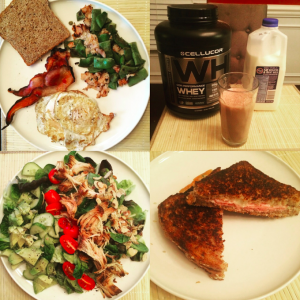
Clockwise, starting from the top left picture: bacon and an over-easy egg with sautéed green beans and diced turkey meat, side of Ezekiel toast; whey protein shake with milk; grilled ham and cheese sandwich; giant chicken salad.
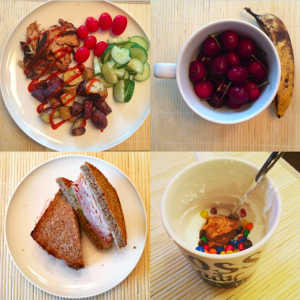
Balsamic chicken and roasted fingerling potatoes with cherry tomatoes and cucumber; giant bowl of cherries and a banana; ham, turkey, and cheese sandwich; Greek yogurt with mini m&m’s and crunchy peanut butter.
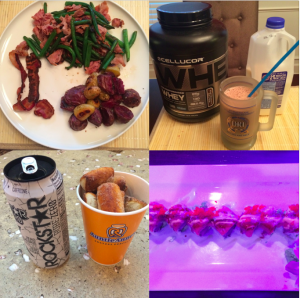
Bacon, roasted fingerling potatoes, and green beans sautéed with ham; protein shake with milk; Rockstar energy drink and a cup of cinnamon sugar soft pretzels (at the mall); spicy tuna roll with a side of miso soup and edamame (not pictured).
For specifics on my total food amounts and macronutrient breakdown, find me on MyMacros+ at SoheeFit.
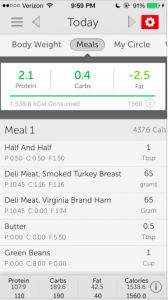
On some days, you may even think that maybe I’m actually a member of the “clean eating” camp. But nay.
To really drill the point home, I’ve asked my assistant Lauren Dasher to send over her daily food as well. (You should follow her on Instagram, by the way – she’s an avid poster and comes up with some of the best meals!) Here’s what she eats:
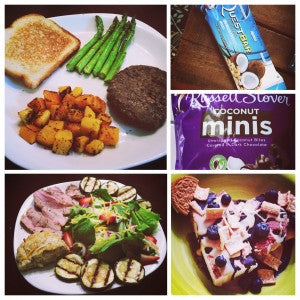
Toast with butter, asparagus, lean beef hamburger, butternut squash; Quest coconut cashew bar; Russell Stover Minis – dark chocolate coconut (2-3/day); protein cheesecake with blueberries, 1/2 Smores Oreo, cereal, and a coconut oil “magic shell”; grilled pork loin, grilled zucchini, and salad with reduced fat cheddar and a homemade cheddar Greek yogurt biscuit.
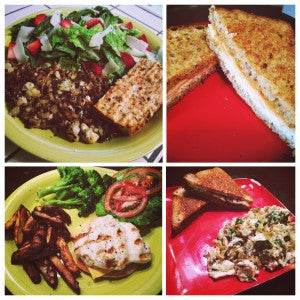
Chicken meatloaf with salad and Alexia hashbrown/cauliflower mix; peanut butter, cream cheese, and turkey on wheat bread; egg whites with mushrooms, veggies, and cheese with a peanut butter, banana, and chocolate chip grilled sandwich; grilled chicken sandwich on a bun with a side of roasted red potatoes and steamed broccoli topped with fat free cheese.
What do you notice in the pictures above?
- We make a point to consume lots of colorful veggies, plenty of fruit, and high quality protein.
- When we actually do eat junk food, the portions are incredibly moderate.
- None of the days above are perfect, but that doesn’t matter because “perfect” eating is elusive.
- We honor our personal preferences, and that means that every day of eating might be slightly different.
Truth be told, flexible dieting is a mindset more than anything.
We have the freedom to eat whatever foods we please, albeit in controlled quantities. As well, we understand that just because we can eat a food does not mean that we necessarily have to. That means that if you don’t like Poptarts, then good news for you: you don’t have to eat them – ever!
How can I make flexible dieting work for me?
Valid question.
You’ve probably read or heard about people who have been able to eat cookies all the way into show day or lick an ice cream cone into Shredsville. I can assure you that despite the food porn photos flooding your Instagram feed, those people are not eating sugar all the doo-dah day. Don’t be fooled into thinking that that’s all they eat. Quite the contrary, actually.
Rather, they control their overall daily calorie intake and likely are tracking the total number of grams of protein, carbohydrates, and fats they consume. More specifically, they tailor their dietary intake toward their specific fitness goal, be it fat loss, muscle gain, or anywhere along the gamut.
You have to monitor your calorie intake, first and foremost (Schoeller, 2009).
To lose weight, you must be in a caloric deficit; to put on weight, you must be in a caloric surplus. This is the first law of thermodynamics (energy cannot be created or destroyed) and is the number one most important determinant of body weight change. So yes, theoretically speaking, you could follow the Twinkie Diet just like Dr. Mark Haubs did and lose bodyfat, provided that you are at a caloric deficit.
(By the way, if you missed our podcast episode with Dr. Mark Haubs himself, you can listen below.)
Second, ensure that you are consuming sufficient protein.
The Recommended Daily Allowance (RDA) for protein is currently set at 0.8g/kg bodyweight/day, but this is merely a minimum number, not a maximum, as many tend to believe. In other words, the implication that consuming above the RDA for protein is harmful is flat-out incorrect.
In fact, Dr. Don Layman, professor of human nutrition at the University of Illinois Urbana-Champaign, points out numerous flaws with the RDA, including: failure to recognize that protein intake is inversely proportional to energy intake (Millward, 2004); failure to recognize that protein utilization efficiency decreases throughout adult life (Wolfe, 2006); and the incorrect implication that consuming about the RDA for protein is harmful, among others (Layman, 2009).
The point is that we can and probably should consume above and beyond the RDA for protein – up to 2-3g/kg bodyweight/day for an active, resistance training individual, according to Dr. Stu Phillips.
Third, manipulate carbohydrate and fat intake accordingly, and vary your food sources.
If you restrict your food choices, you can find yourself deficient in micronutrients. In fact, a study conducted on bodybuilders found that the females, despite consuming adequate total calories, were woefully deficient in calcium in large part due to their avoidance of dairy(Kleiner SM et al., 1990). Swinging to the other extreme, excessive intake of vitamins and minerals can also be observed in food-restricted conditions (Bamman et al., 1993). So here we have simultaneous micronutrient deficiencies and excess.
What does this mean? Strive for a diet rich in food variety. Get in your colorful veggies, enjoy dairy in moderation (unless you are intolerant, of course), and don’t omit any single food group arbitrarily.
Last, allot up to 20% of your daily intake for discretionary calories.
I’m not aware of any research that suggests that a small sprinkling of junk food in your dietary has any adverse health effects. In fact, a study shows that flexible dieting is correlated with absence of overeating, lower body mass, and lower levels of depression and anxiety (Smith et al., 1999). Surprised?
And of course, we can’t forget that the more you restrain your diet, the higher risk for eating disorders (Jacobi et al., 2004) – and we don’t want that.
I like setting 20% as the upper limit because it still ensures that the large majority of your daily intake comes from whole, minimally processed foods. And since we absolutely do care about our health, I should note as well that consuming 20% of daily calories from added sugars does not adversely affect micronutrient consumption (Gibson, 2007).
You know what I like the most about this? Making some room for daily treats allows you to maintain your quality of life. As in, you can still go out on a date with your boo, you can still hit up that BBQ, and yes, you can absolutely chow down on some movie theater popcorn every now and then. You simply have to be smart about managing your caloric (and macronutrient) intake.
Eat, lift, thrive, baby.
If you’re looking for more information, below are some solid starting points for you.
How to transition from “clean eating” to flexible dieting:
Revelations with flexible dieting:
And if you’re looking for a little more guidance, you’re in luck!
I’ve just launched my next product, The Beginner’s Guide to Macros.
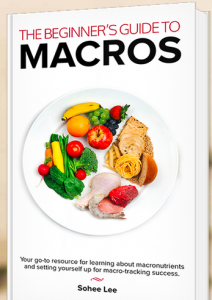
This is your go-to resource for learning about macronutrients and setting yourself up for macro-tracking success. Here’s what the e-book covers:
- What’s a macro?
- Planning your macros
- Adjusting and tweaking your numbers
- Making your diet work for your life
- Practical tips and tricks
- Weaning yourself off of macro counting
- Mindset hacks to help you succeed
- Recommended resources
On top of that, your purchase comes with indefinite membership to an exclusive Facebook support group, where you’ll have access to some of the industry’s top coaches and other like-minded individuals for accountability and support.
From Tuesday, July 7 to Friday, July 10, 2015, I’m running a launch sale for $14.99.
This is a sweet, sweet deal that you don’t want to miss out on.
(If you’ve already purchased How to Count Macros, the first edition of the book, and you’re wondering if this next one is worth buying: if you’ve got a good handle of tracking macros and feel like you know your stuff, then you probably don’t need TBGM. But if you like learning new things and want to be a part of the Facebook support group, then you might want to get your hands on this baby!)

Again, you can grab your copy at this link.
If you have any questions about the product at all, please direct them to macros(at)soheefit(dot)com.
References
Bamman, M.M., Hunter, G.R., Newton, L. E., Roney, R. K., Khaled, M.A. (1993). Changes in body composition, diet, and strength of bodybuilders during the 12 weeks prior to competition.
Gibson, S.A. (2007). Dietary sugars intake and micronutrient adequacy: a systematic review of the evidence. Nutr Res Rev. 20(20:121-31.
Jacobi, C., Hayward, C., de Zwaan, M., Kraemer, H. C., & Agras, W. S. (2004). Coming to terms with risk factors for eating disorders: application of risk terminology and suggestions for a general taxonomy. Psychological Bulletin. 130:19-65.
Millward, D.J. (2004). Macronutrient intakes as determinants of dietary protein and amino acid adequacy. J Nutr. 134:1588S-1596S.
Kleiner, S.M., Bazzarre, T.L., Litchford, M.D. (1990). Metabolic profiles, diet, and health practices of championship male and female bodybuilders. J Am Diet Assoc. 90(7):962-7.
Layman, D.K. (2009). Dietary Guidelines should reflect new understandings about adult protein needs. Nutr & Metab. 6:12
Schoeller, DAA. (2009). The energy balance equation: looking back and looking forward are two very different views. Nutr Rev. 67(5):249–254.
Smith, C.F., Williamson, D.A., Bray, G.A., & Ryan, D.H. (1999) Flexible vs. rigid dieting strategies: relationship with adverse behavioral outcomes. Appetite. 32(3):295-305.
Wolfe, R.R. (2006). The underappreciated role of muscle in health and disease. Am J Clin Nutr. 84:475-482.




